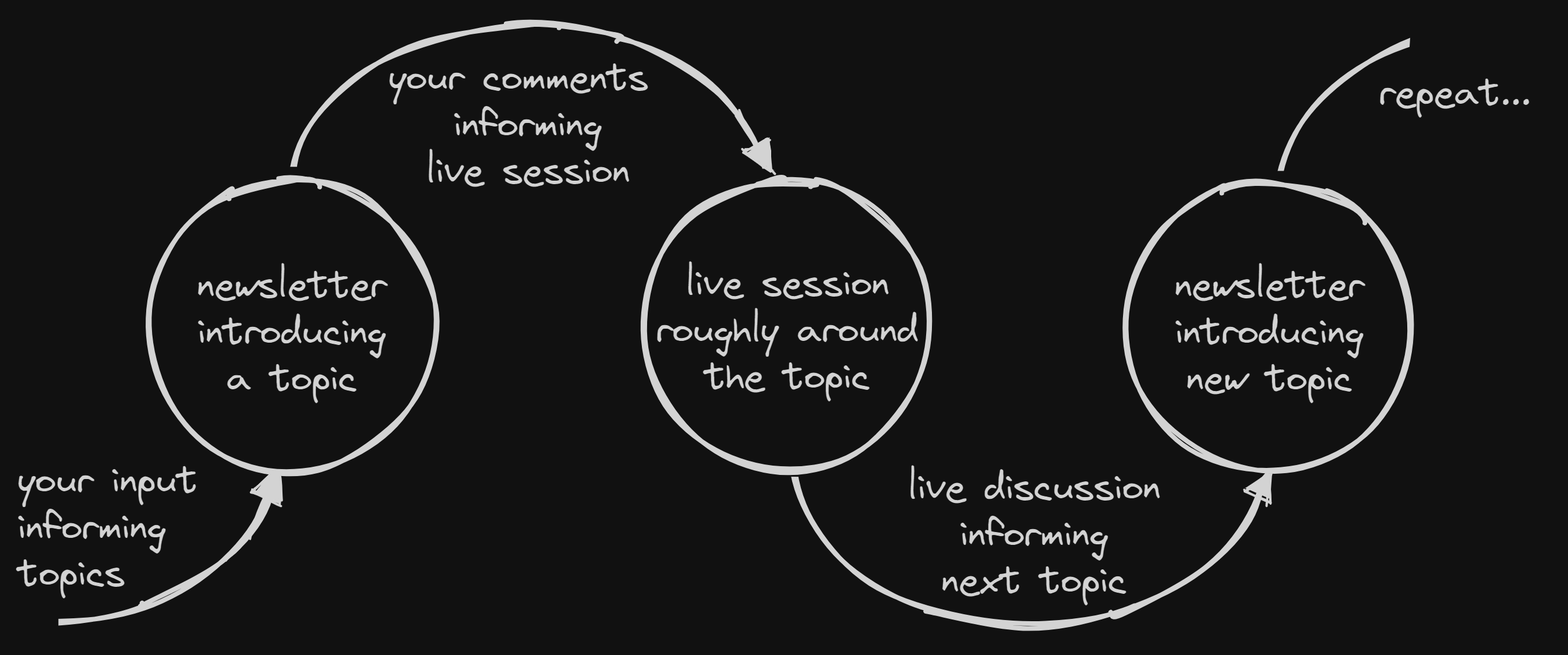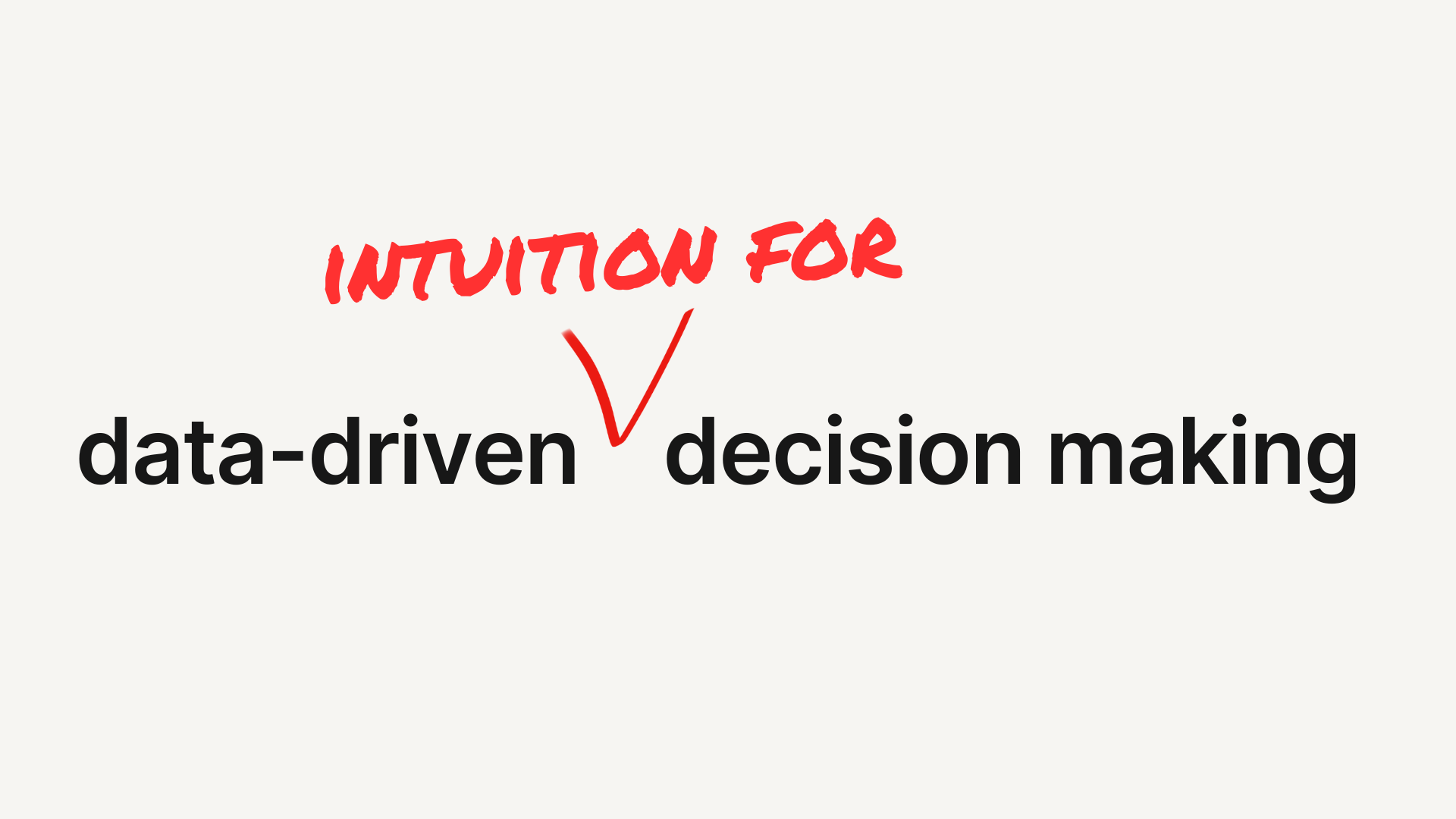BLDG.Insights #001 - data-driven intuition for sustainable decision-making
So, here I am, writing a newsletter I never thought I'd start.
After starting my own business, I’ve come to see newsletters in a whole new light - not as company updates but as a tool to engage with you and create a conversation.
By the way, if you are interested in what I do now, check out this article.
Here is how this will go…
I aim to send a newsletter every two weeks, which will hopefully hit the right nerve to spark discussions or raise further questions.
In the week following the newsletters, we will have a live session.
These sessions are a chance for us to dive deeper into the topics or to explore any new questions that have come up. They also provide an opportunity for you to ask specific questions and get direct feedback.

Newsletter flow
With this feedback loop, future topics can be tailored much better to your interests.
So here is the first edition...
I hope you enjoy reading it.

In this first edition, let's dive deeper into something we touched on briefly two weeks ago in my first live session - the role of intuition and that "gut feeling" in decision-making and how that relates to the much talked about data-drived decision-making.
Missed the live session? You can watch it back here.
Decision-Making in Construction is complex
Ok, let’s be clear: Decision-making in construction, especially on topics around sustainability is not straightforward.
Despite our best efforts or even claims to be data-driven in our decisions, the reality of multi-year projects teaches us differently.
Often, we find ourselves or the partners we work with going back to the things that worked well in the past rather than what all the data we have collected suggests.
We do that based on earlier experiences.
Consider for instance this case:
Say that in your last project you might have implemented an innovative prefab floor system; an approach that ultimately saved a significant amount of weight and carbon emissions and was assembled on-site with minimal impact.
However, getting there was everything but simple. The system was new to everyone involved, from architects and engineers to contractors and the city's planning department.
This led to countless meetings to figure out all the unique details, get the right permissions to use the system locally, tackle fire safety concerns, addres concerns on acoustics, and overcome other unforeseen setbacks.
Despite hurdles, the project was successfully completed after two years of planning and three years of construction.
And although it was just ONE example, you have surely built up an enormous amount of experience with this one project. And it's those rich experiences we make during long projects that put our sector in a different light when it comes to data-based decision-making.
Experience can not be underrated.
Now picture this…
in the next project, a designer presents a compelling proposal to use a new floor system to reduce carbon impact in your project.
They did a really good job comparing all kinds of variants and options, created life cycle assessments, and life cycle costing, found 3 different suppliers, and a lot of use cases, just not an example in the country in question yet.
All the data is summarized in an easy-to-follow story with graphics and numbers.
But something is lacking. The feeling that it will work.
The experience.
A new system? Haven’t we just spent 5 years figuring out how that other one works which also achieved some good savings on carbon emissions?
The Limits of Data-Driven Decisions
So, what is it with data that is not enough in those cases?
Data is invaluable, yet it only paints part of the picture.
A construction project is a complex beast, influenced by too many factors to be covered by the scope of that initial data.
The final decision often rests not on spreadsheets and graphs but on the seasoned intuition of those at the helm. And that intuition was made through years of hands-on experience.
The Role of Experience in Shaping Intuition
It is thus our experience that is a powerful teacher. It informs our gut feeling, enabling us to make decisions that no amount of data can fully justify.
This isn't to say that data isn't crucial; rather, it should serve to inform and enhance our intuition and back it up. Not replace it.
So should I trust only my intuition then?!
Well, no. While intuition can be a great guide, it can not be solely relied on, especially not without the right data and experience.
That is because intuition has its flaws, too. Mainly, because it is subject to many biases that can skew our perception.
You need to be aware of these biases so that your intuition affirms a decision that is factually based on rational thinking. Some common biases include:
Confirmation Bias: This is basically the tendency to search for and favour information in a way that confirms one’s preexisting beliefs or hypotheses.
Anchoring Bias: Relying too heavily on the first piece of information received (the "anchor") when making decisions, even if it is irrelevant.
Overconfidence Bias: The inclination to overestimate one's own abilities or the accuracy of one's intuitions.
Availability bias: A mental shortcut that jumps to the immediate examples that come to one’s mind during decision-making.
Status Quo Bias: The preference to keep things the same, resisting changes that might be beneficial.Lorem ipsum dolor sit amet
Strategies to enhance Decision-Making
With all that being said, in my opinion, it's the creation of experience that we should focus on.
And this is where the data plays a crucial role.
It can help us develop that experience.
Almost like in machine learning where an algorithm is trained with a dataset, we can use our practice with data to inform our experience with sustainability.
Here are some things you can do to train your experience to build your intuition while being aware of the flaws of intuition…
Build Experiential Knowledge: Actively seek opportunities to gain firsthand experience. Whether it’s experimenting with new building techniques on smaller, less risky projects or conducting detailed case studies, each experience enriches your intuition. Get your hands on Lifecycle analysis or sit with the ones in your team that are performing it. Try to get a feel for those numbers so you are better able to compare without detailed analysis later.
Acknowledge and Understand Bias: Recognize that there is bias involved when you’re relying solely on intuition. Identifying it can open your mind to understanding data showing something new or unexpected.
Learn and Adapt: Focus on the learnings each project gives you. Not only does learning enhance your decision-making capability, but it also gives you a positive experience and endorphins come free when thinking back and talking about that experience. Believe me, I’ve been there.
Innovate Decision Processes: Develop processes that allow for the inclusion of new ideas and continuous improvement, prevent biases and actively create an environment for learning. I strongly believe that this is one of the keys to successfully integrating sustainability into our processes and focused my entire MBA thesis on developing such processes. No surprise then that I will talk about it some more in the future.
A Call for “Data-Informed Intuition”
To sum up, I hope you don’t get me wrong. I am not arguing against data-based decisions…
Quite the opposite.
Data has a very important place: to build a more informed intuition.
What if we can use the data that we can create today to build our experience and with that shape our intuition.
By combining data-driven approaches with practice on real project experiences, we can craft a decision-making approach that feels as right as it is rational.
Join Me for a Discussion next Friday,
17 May at 12:30 CET
Let's explore how we can make better decisions to integrate sustainability into our projects. Discover tools and strategies to minimize biases in your meetings and learn about structured decision-making processes.
And in the meantime, I’m eager to hear your thoughts and experiences on this topic, so please feel free to hit reply and share your insights or questions.
Have a great week,
Marc
P.S.: Hopefully, this first edition wasn't too theoretical. It was something that I've been thinking about and wanted to share with you. The next edition will focus more on practical applications, inspired by the topics you've already suggested.
Ready to start your journey to sustainable practices? I'm here to guide your ascent. Book a first call to explore how we can make a meaningful impact on the Built Environment together.
© 2024 BLDG.Systems | Amsterdam | Marc Hoppermann | +31(6)57659595 | hello(at)bldg.systems | VAT:NL004765656B47 | KVK:89861175
